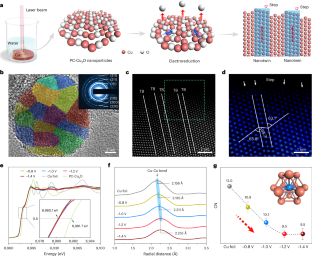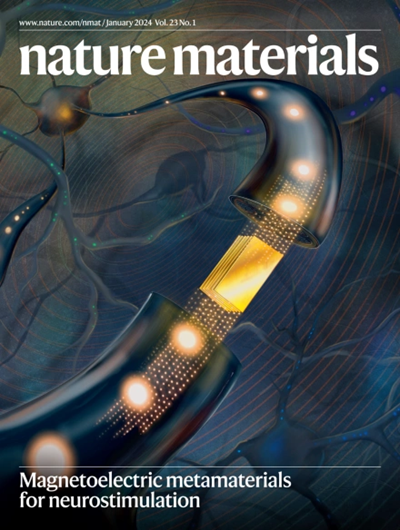Electroreduction-driven distorted nanotwins activate pure Cu for efficient hydrogen evolution
IF 37.2
1区 材料科学
Q1 CHEMISTRY, PHYSICAL
引用次数: 0
Abstract
Precious metals such as Pt are favoured as catalysts for the hydrogen evolution reaction (HER) due to their excellent catalytic activity. However, the scarcity and high cost of precious metals have prompted researchers to explore cheaper alternatives such as Cu. Nevertheless, Cu shows poor catalytic performance due to weak binding with intermediates. Here the catalytic activity of pure Cu is activated via electroreduction-driven modification of the local structure, achieving a HER catalytic performance superior to commercial Pt/C catalysts for working current densities greater than 100 mA cm−2 in acid electrolyte. Activation involved two steps. First, polycrystalline Cu2O nanoparticles were prepared via pulsed laser ablation, resulting in grain boundaries within the Cu2O particles as observed using electron microscopy. Next, the Cu2O particles were electroreduced to pure Cu, inducing the formation of distorted nanotwins and edge dislocations. These local structures induce high lattice strain and decrease the Cu coordination number, enhancing the interaction between Cu and intermediates—as calculated using density functional theory—leading to the excellent catalytic activity and durability of the catalyst. Our observations show that low-cost pure Cu can be a promising HER catalyst for large-scale industrial applications. Low-cost Cu catalysts for the hydrogen evolution reaction (HER) can transform industrial water electrolysis, but pure Cu typically exhibits a negligible HER. Here, combining pulsed laser ablation and subsequent electroreduction, Cu nanotwins form that enable the HER at an overpotential of 301 mV, with 125 h of stable operation at a current density of 500 mA cm−2.


求助全文
约1分钟内获得全文
求助全文
来源期刊

Nature Materials
工程技术-材料科学:综合
CiteScore
62.20
自引率
0.70%
发文量
221
审稿时长
3.2 months
期刊介绍:
Nature Materials is a monthly multi-disciplinary journal aimed at bringing together cutting-edge research across the entire spectrum of materials science and engineering. It covers all applied and fundamental aspects of the synthesis/processing, structure/composition, properties, and performance of materials. The journal recognizes that materials research has an increasing impact on classical disciplines such as physics, chemistry, and biology.
Additionally, Nature Materials provides a forum for the development of a common identity among materials scientists and encourages interdisciplinary collaboration. It takes an integrated and balanced approach to all areas of materials research, fostering the exchange of ideas between scientists involved in different disciplines.
Nature Materials is an invaluable resource for scientists in academia and industry who are active in discovering and developing materials and materials-related concepts. It offers engaging and informative papers of exceptional significance and quality, with the aim of influencing the development of society in the future.
文献相关原料
公司名称
产品信息
阿拉丁
Potassium bicarbonate
 求助内容:
求助内容: 应助结果提醒方式:
应助结果提醒方式:


